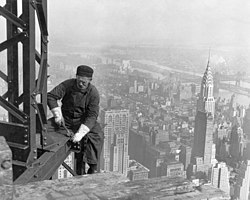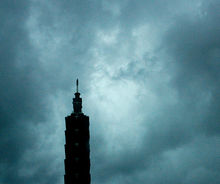Skyscraper design and construction

The design and construction of skyscrapers involves creating safe, habitable spaces in very tall buildings. The buildings must support their weight, resist wind and earthquakes, and protect occupants from fire. Yet they must also be conveniently accessible, even on the upper floors, and provide utilities and a comfortable climate for the occupants. The problems posed in skyscraper design are considered among the most complex encountered given the balances required between economics, engineering, and construction management.
Basic design considerations
Good structural design is very important in most building designs, but particularly for skyscrapers since even a small chance of catastrophic failure is unacceptable given the high prices of construction. This presents a paradox to civil engineers: the only way to assure a lack of failure is to test for all modes of failure, in both the laboratory and the real world. But the only way to know of all modes of failure is to learn from previous failures. Thus, no engineer can be absolutely sure that a given structure will resist all loadings that could cause failure, but can only have large enough margins of safety such that a failure is acceptably unlikely. When buildings do fail, engineers question whether the failure was due to some lack of foresight or due to some unknowable factor.
Loading and vibration

Hard vibrations
Shear walls
A shear wall, in its simplest definition, is a wall where the entire material of the wall is employed in the resistance of both horizontal and vertical loads. A typical example is a brick or cinderblock wall. Since the wall material is used to hold the weight, as the wall expands in size, it must hold considerably more weight. Due to the features of a shear wall, it is acceptable for small constructions, such as suburban housing or an urban brownstone, to require low material costs and little maintenance. In this way, shear walls, typically in the form of plywood and framing, brick, or cinderblock, are used for these structures. For skyscrapers, though, as the size of the structure increases, so does the size of the supporting wall. Large structures such as castles and cathedrals inherently addressed these issues due to a large wall being advantageous (castles), or ingeniously designed xx(cathedrals). Since skyscrapers seek to maximize the floor-space by consolidating structural support, shear walls tend to be used only in conjunction with other support systems.
Steel frame
The classic concept of a skyscraper is a large steel box with many small boxes inside it. The genius of the steel frame is its simplicity. By eliminating the inefficient part of a shear wall, the central portion, and consolidating support members in a much stronger material, steel, a skyscraper could be built with both horizontal and vertical supports throughout. This method, though simple, has drawbacks. Chief among these is that as more material must be supported (as height increases), the distance between supporting members must decrease, which actually, in turn, increases the amount of material that must be supported. This becomes inefficient and uneconomic for buildings above 40 stories tall as usable floor spaces are reduced for supporting column and due to more usage of steel.[1][2]
Tube frame

Since 1963, a new structural system of framed tubes appeared. Fazlur Khan and J. Rankine defined the framed tube structure as "a three dimensional space structure composed of three, four, or possibly more frames, braced frames, or shear walls, joined at or near their edges to form a vertical tube-like structural system capable of resisting lateral forces in any direction by cantilevering from the foundation."[3] Closely spaced interconnected exterior columns form the tube. Horizontal loads (primarily wind) are supported by the structure as a whole. About half the exterior surface is available for windows. Framed tubes allow fewer interior columns, and so create more usable floor space. Where larger openings like garage doors are required, the tube frame must be interrupted, with transfer girders used to maintain structural integrity. Tube structures cut down costs, at the same time allow buildings to reach greater heights. Tube-frame construction was first used in the DeWitt-Chestnut Apartment Building, designed by Khan and completed in Chicago in 1963.[4] It was used soon after for the John Hancock Center and in the construction of the World Trade Center.
A variation on the tube frame is the bundled tube, which uses several interconnected tube frames. The Willis Tower in Chicago used this design, employing nine tubes of varying height to achieve its distinct appearance. The bundle tube design was not only highly efficient in economic terms, but it was also "innovative in its potential for versatile formulation of architectural space. Efficient towers no longer had to be box-like; the tube-units could take on various shapes and could be bundled together in different sorts of groupings."[5] The bundled tube structure meant that "buildings no longer need be boxlike in appearance: they could become sculpture."[6] Cities have experienced a huge surge in skyscraper construction, thanks to Khan's innovations allowing economic skyscrapers.
The tubular systems are fundamental to tall building design. Most buildings over 40-stories constructed since the 1960s now use a tube design derived from Khan’s structural engineering principles,[1][7] examples including the construction of the World Trade Center, Aon Centre, Petronas Towers, Jin Mao Building, and most other supertall skyscrapers since the 1960s.[8] The strong influence of tube structure design is also evident in the construction of the current tallest skyscraper, the Burj Khalifa.[6]
The elevator conundrum

The invention of the elevator was a precondition for the invention of skyscrapers, given that most people would not (or could not) climb more than a few flights of stairs at a time. The elevators in a skyscraper are not simply a necessary utility like running water and electricity, but are in fact closely related to the design of the whole structure. A taller building requires more elevators to service the additional floors, but the elevator shafts consume valuable floor space. If the service core (which contains the elevator shafts) becomes too big, it can reduce the profitability of the building. Architects must therefore balance the value gained by adding height against the value lost to the expanding service core.[9] Many tall buildings use elevators in a non-standard configuration to reduce their footprint. Buildings such as the former World Trade Center Towers and Chicago's John Hancock Center use sky lobbies, where express elevators take passengers to upper floors which serve as the base for local elevators. This allows architects and engineers to place elevator shafts on top of each other, saving space. Sky lobbies and express elevators take up a significant amount of space and add to the amount of time spent commuting between floors. Other buildings such as the Petronas Towers use double-deck elevators allowing more people to fit in a single elevator and reaching two floors at every stop. It is possible to use even more than two levels on an elevator although this has yet to be tried. The main problem with double-deck elevators is that they cause everyone in the elevator to stop when only people on one level need to get off at a given floor.
See also
- List of architects of supertall buildings
- World's littlest skyscraper
- List of cities with most skyscrapers
References
- ^ a b "Lehigh University: Fazlur Rahman Khan Distinguished Lecture Series". Lehigh.edu. Retrieved 2012-08-15.
- ^ http://darkwing.uoregon.edu/~struct/resources/pencil/systems.htm#types
- ^ "Evolution of Concrete Skyscrapers". Retrieved 2007-05-14.
- ^ Alfred Swenson & Pao-Chi Chang (2008). "building construction". Encyclopædia Britannica. Retrieved 2008-12-09.
{{cite web}}: Italic or bold markup not allowed in:|publisher=(help) - ^ "Khan, Fazlur Rahman". Banglapedia. Retrieved 2008-12-09.
- ^ a b Bayley, Stephen (5 January 2010). "Burj Dubai: The new pinnacle of vanity". The Daily Telegraph. Retrieved 2010-02-26.
- ^ "Top 10 world's tallest steel buildings". Constructionweekonline.com. Retrieved 2012-08-15.
- ^ Ali, Mir M. (2001), "Evolution of Concrete Skyscrapers: from Ingalls to Jin mao", Electronic Journal of Structural Engineering, 1 (1): 2–14, retrieved 2008-11-30
- ^ "How Skyscrapers Work: Making it Functional". HowStuffWorks. Retrieved 2008-10-30.
Further reading
- Macaulay, David (1987-10-26). Unbuilding (Reprint ed.). Houghton Mifflin/Walter Lorraine Books. p. 80. ISBN 0-395-45425-5.
- Sabbagh, Karl (1991-07-01). Skyscraper: The Making of a Building (Reprint ed.). Penguin (Non-Classics). p. 400. ISBN 0-14-015284-9.
- Chew, Michael Y. L.; Michael Chew Yit Lin (2001-02-15). Construction Technology for Tall Buildings (2 Sub ed.). Singapore University Press. p. 436. ISBN 981-02-4338-3.
External links
- How Stuff Works explanation of Skyscrapers
- "Skyscrapers will continue to be built, author of book on tall buildings says". Archived from the original on April 25, 2006. Retrieved 2007-05-14.
{{cite web}}: Unknown parameter|deadurl=ignored (|url-status=suggested) (help)
